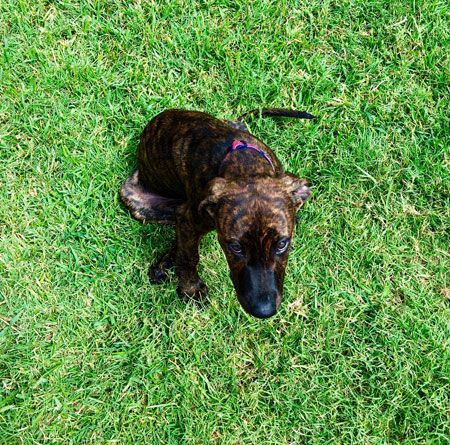Just Ask the Expert: Whats the No. 1 way to keep my puppy from eating his No. 2s (and other unsavory snacks)?
We may not know why puppies can view acorns, pebbles and poop as lip-smacking delicacies, but we do know ways to curb their inappropriate appetites.

Busted. (Photo courtesy of Mindy Valcarcel)
We welcome questions on puppy problems and other clinical concerns from veterinarians and veterinary technicians. Click here to submit your question, or send an email to vm@advanstar.com with the subject line "Just Ask the Expert."
Q.What is the best way to help prevent puppies prone to pica (and in which gastrointestinal problems or parasites have been ruled out) from eating things they shouldn't, such as rocks, pebbles and acorns when outside for potty breaks? Even vigilant owners can't catch every instance. Is there a way to train the puppies now to stop these indiscretions so that it's not a lifelong problem, possibly necessitating multiple surgeries to remove foreign bodies?
A. Pica refers to the persistent ingestion of nonfood items and is related to coprophagia, the eating of fecal material. The causes of these conditions are not well understood. Some thought has focused on nutritional deficiencies, but this has not been proven. Some think it may be an attention-getting behavior, while others view it as a compulsive disorder. It seems to be seen more often in overly active puppies seeking stimulation from their environments.
First, a note on what doesn't work. Putting meat tenderizer or commercial products meant to reduce coprophagia in the pet's food has not proven to be helpful. Placing bitter tasting compounds such as bitter apple or bitter orange on non-food items has been found to be similarly ineffective in reducing coprophagia and pica. And while punishment may feel natural, it can deteriorate the human-pet bond and can even lead to aggressive behavior.
It's best to think of pica and coprophagia as habits. For habits to diminish, they need to be reduced or eliminated for an extended period. This takes patience, persistence and consistency on the part of owners.
To manage both pica and coprophagia, owners need to:
1. Deny the puppy access to the nonfood items. Owners should remove items the dog is prone to ingest from its environment, if possible. This could involve picking up toys around the home or immediately removing fecal matter from the puppy's pen or from the yard. It could also mean avoiding taking the dog to areas containing sticks, rocks, etc.
2. Redirect the puppy away from ingestion attempts. When taking the dog into a susceptible area (e.g. on walks, in the yard or pen to eliminate), owners should be vigilant in keeping the dog from ingesting nonfood items. This can be accomplished by keeping the dog on a leash and by using a basket muzzle (if necessary).
3. Provide the puppy with plenty of appropriate food sources. When outside the home, have the owner try rewarding the puppy with a small, highly palatable treat for “checking in” when its name is called. The idea is to make focusing on the owner pay off more than searching the environment for items to ingest.
At home, puppies should be given toys filled with peanut butter or a rawhide (or a similar alternative) to reduce their desire to hunt for other items. It's important that the item is provided before the dog begins seeking out nonfood items. Providing a high-fiber diet can also help in that it can increase bulk and reduce some of the need to ingest foreign materials.
Veterinary scene down under: IV fluid shortage updates, and more news
September 3rd 2024Updates on the intravenous fluid shortage impacting Australian veterinary practices, a welcome funding boost for the Veterinary and Community Care charity, and Australia’s first Fear Free Certified veterinary practice.
Read More